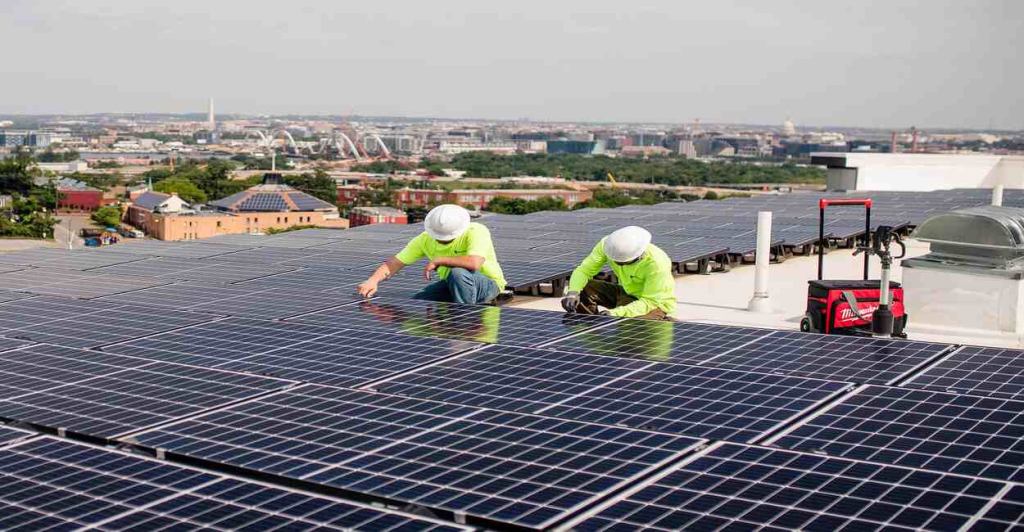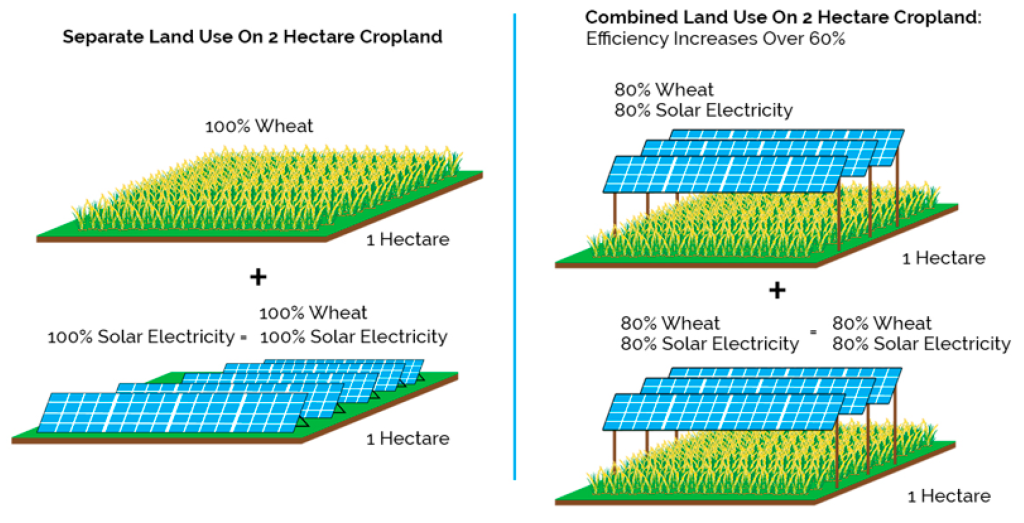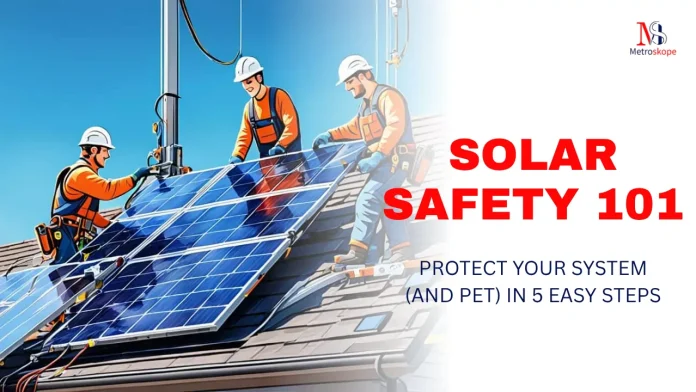Installing solar panels is one of the smartest investments you can make for your home, but like any valuable asset, your solar system needs proper protection to maintain optimal performance and safety.
Whether you’re dealing with curious pets, harsh weather conditions, or potential electrical hazards, following proper safety protocols ensures your system operates efficiently for decades while keeping your family and furry friends safe.
Why Solar System Protection Matters
Solar panels are built to withstand harsh conditions, but they’re not invincible. Modern solar panels are generally categorized as nonhazardous according to EPA chemical analysis standards, yet they still face risks from external factors.
The average solar system represents a significant financial investment—typically $15,000 to $25,000—making protection essential for maximizing return on investment.

Common threats to solar systems include:
- Animal interference and nesting
- Extreme weather conditions (hail, lightning, high winds)
- Electrical hazards and fire risks
- Physical damage from debris
- Pet-related incidents and curiosity-driven damage
“Solar power is improving human health by reducing our reliance on electric power sources that emit toxic chemicals such as sulfur dioxide, nitrogen oxides, and fine particulate matter.”1
Step 1: Secure Your System Against Animal Interference
Understanding Animal Threats
Animals pose one of the most common and preventable threats to solar installations.
Birds, squirrels, rodents, and even larger animals can cause thousands of dollars in damage through nesting, chewing wires, or physical impact.
Protection Solutions
Install Mesh Barriers
The most effective protection method is installing high-grade metal mesh or “critter guards” around your panels.
These barriers:
- Prevent birds and squirrels from nesting underneath panels
- Block access to wiring and sensitive components
- Allow proper airflow while maintaining protection
- Resemble chicken wire but use stronger materials designed for solar applications
Use Physical Deterrents
- Bird spikes: Mount short metal teeth around the system perimeter
- Wire mesh shields: Cover vulnerable areas with protective netting
- Strategic placement: Position panels to minimize animal access points
Farm and Rural Considerations
For rural installations, larger animals require special attention.
While it’s generally safe for smaller animals like sheep and poultry to graze near ground-mounted systems, larger animals such as cattle could damage the system. Consider:
- Raising ground-mount systems to 4-foot clearance for livestock
- Installing protective fencing around sensitive areas
- Choosing calmer animals for grazing near installations
Step 2: Weather-Proof Your Investment
Lightning Protection
Lightning strikes pose serious risks to solar installations, potentially damaging expensive inverters and electrical components. Essential protection measures include:
Grounding Systems
- Ensure grounding resistance stays below safety standards
- Install proper grounding for all system components
- Regularly inspect grounding connections for corrosion or loosening
Surge Protection Devices (SPDs)
Install a three-tier protection system:
| SPD Type | Installation Location | Protection Level |
|---|---|---|
| Type 1 | Main distribution board | Direct lightning strikes |
| Type 2 | Household electrical panel | Indirect strikes, overvoltages |
| Type 3 | Near specific devices | Individual device protection |
Hail Damage Prevention
Choose Resilient Panels
When purchasing solar panels, select models with proper certifications:
- UL 61730 rating: Tested to withstand 1-3 inch hail at speeds up to 88.3 mph
- IP68 rating: Waterproof and dustproof protection
- IEC 61730 certification: International safety standards compliance
Protective Covering Options
For extreme weather events:
- Hardcover protection: Maximum impact resistance (blocks light during use)
- Padded hail covers: Absorb medium hailstone impacts
- Emergency tarps: Quick, cost-effective temporary solution
Wind and Storm Preparation
- Secure mounting systems to handle wind loads up to local building codes
- Regularly inspect mounting hardware for signs of loosening or corrosion
- Trim surrounding vegetation to prevent branch damage during storms
Step 3: Maintain Electrical Safety Standards

Professional Installation Requirements
Electrical safety begins with proper installation. Professional installers should:
- Use appropriate Personal Protective Equipment (PPE):
- Safety helmets and protective eyewear
- Cut-resistant gloves for handling modules
- Safety harnesses and fall protection gear
- Steel-toed boots with rubber soles
Ongoing Electrical Maintenance
Regular Safety Inspections
Conduct quarterly safety checks focusing on:
- Wire integrity: Look for signs of animal damage, wear, or corrosion
- Connection tightness: Loose connections create fire hazards
- Grounding continuity: Ensure all grounding connections remain secure
- Inverter function: Monitor for error codes or unusual sounds
Warning Signs to Address Immediately
- Unusual odors (burning, ozone smell)
- Visible arcing or sparking
- Inverter error messages
- Significant performance drops
- Physical damage to components
Fire Prevention
Solar panels carry DC current whenever exposed to light, creating potential fire risks if systems aren’t properly maintained. Key prevention strategies:
- Use only tier-1 solar panels and components for installation
- Perform annual professional inspections of all electrical connections
- Install arc-fault circuit interrupters (AFCIs) where required by code
- Maintain proper wire sizing and ensure all systems are properly earthed
Step 4: Create Pet-Safe Zones Around Your System
Understanding Pet Behavior Around Solar
Pets, especially cats and dogs, are naturally curious about new installations.
Solar panels themselves are safe for pets, but certain precautions ensure their well-being and system protection.
Pet Safety Guidelines
Safe Distance Recommendations
- Ground-mounted systems: Maintain 3-foot clearance around panels
- Rooftop installations: Ensure pets cannot access roof areas
- Electrical components: Keep inverters and electrical boxes secured and inaccessible
Wire Protection
The primary risk to pets comes from exposed wiring. Protect both your system and pets by:
- Installing conduit protection for all exposed wiring
- Using pet-resistant wire coverings in accessible areas
- Regularly inspecting for signs of chewing or damage
- Training pets to avoid system areas through positive reinforcement
Solar-Powered Pet Amenities
Consider solar-powered pet solutions that provide additional safety benefits:
Solar Pet Kennels
Basic components for DIY solar pet shelter:
- 100-watt solar panel (sufficient for small climate control systems)
- Charge controller to regulate power flow
- Small battery for nighttime operation
- Inverter for AC-powered accessories
Additional Pet Safety Features
- Solar-powered cameras for remote pet monitoring
- Motion detectors to alert you of unusual activity
- Water pumps for automated pet water systems
- Lighting systems for nighttime pet safety
Step 5: Implement Regular Maintenance and Monitoring

Preventive Maintenance Schedule
Monthly Tasks
- Visual inspection for physical damage, debris, or animal activity
- Performance monitoring through system apps or monitoring devices
- Check for shading from growing vegetation
- Clean panels if necessary (typically rainfall provides adequate cleaning)
Quarterly Tasks
- Detailed electrical inspection of accessible components
- Vegetation management around ground-mounted systems
- Inverter performance review and error log checking
- Weather protection assessment (storm damage, wear patterns)
Annual Professional Inspections
Schedule professional maintenance including:
- Complete electrical safety testing
- Mounting system integrity check
- Performance optimization assessment
- Warranty compliance documentation
Performance Optimization
Maximizing Efficiency and Longevity
| Maintenance Task | Frequency | Expected Benefit |
|---|---|---|
| Panel cleaning | As needed | 5-15% performance boost |
| Vegetation trimming | Quarterly | Prevent shading losses |
| Electrical inspection | Annual | Fire prevention, warranty protection |
| Inverter monitoring | Monthly | Early problem detection |
Protective Coating Applications
Consider applying protective coatings to enhance panel longevity:
- UV protection: Prevents discoloration and degradation
- Corrosion resistance: Extends component life
- Easy cleaning: Reduces maintenance requirements
- Abrasion protection: Guards against physical wear
Technology Integration for Enhanced Safety
Smart Monitoring Systems
Modern solar installations benefit from intelligent monitoring technology:
- Real-time performance tracking to identify problems immediately
- Automatic alerts for system anomalies or safety concerns
- Weather integration for storm preparation and damage assessment
- Mobile apps for convenient system management
Additional Safety Considerations
Insurance and Legal Protection
- Notify your homeowner’s insurance about solar installation
- Maintain documentation of all safety measures and maintenance
- Keep warranty information easily accessible
- Understand local permitting requirements and safety codes
Emergency Procedures
Develop and practice emergency response procedures:
- System shutdown procedures for emergencies
- Contact information for installers and emergency services
- Location maps of system components and shutoffs
- Pet evacuation plans that account for solar installations
Cost-Benefit Analysis of Protection Measures
| Protection Type | Initial Cost | Potential Damage Prevention | ROI Timeline |
|---|---|---|---|
| Animal barriers | $200-500 | $2,000-5,000 | 1-2 years |
| Lightning protection | $500-1,500 | $5,000-15,000 | 3-5 years |
| Professional monitoring | $10-30/month | Early problem detection | Ongoing |
| Protective coatings | $300-800 | Extended system life | 5-10 years |
Your Path to Solar Safety Success
Protecting your solar investment and ensuring pet safety doesn’t require complex solutions—just consistent attention to five key areas: animal protection, weather preparation, electrical safety, pet considerations, and regular maintenance.
By implementing these straightforward steps, you’ll maximize your system’s performance, extend its lifespan, and create a safe environment for your entire family, including four-legged members.
Remember that solar panels are designed for decades of safe operation, and with proper protection measures, your system will provide clean, renewable energy while maintaining the highest safety standards.
The small investment in protection measures pays significant dividends in system longevity, performance, and peace of mind.
Whether you’re a new solar owner or looking to upgrade your current protection measures, these five steps provide a comprehensive foundation for solar safety that protects both your investment and your pets.
Start with the basics—secure animal barriers and electrical safety—then build up to more advanced monitoring and protection systems as your budget allows.

